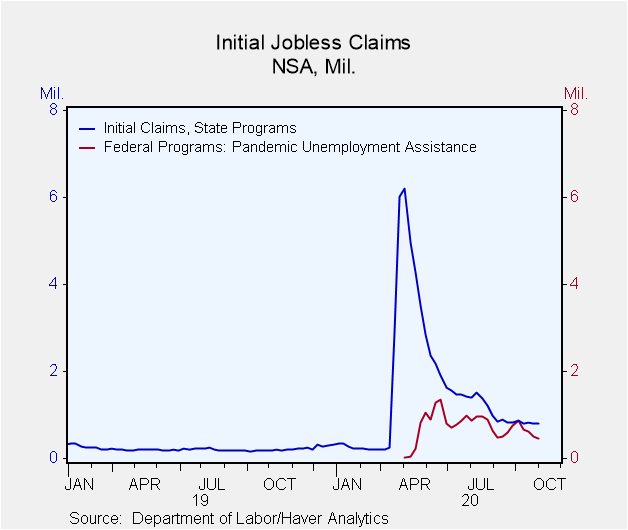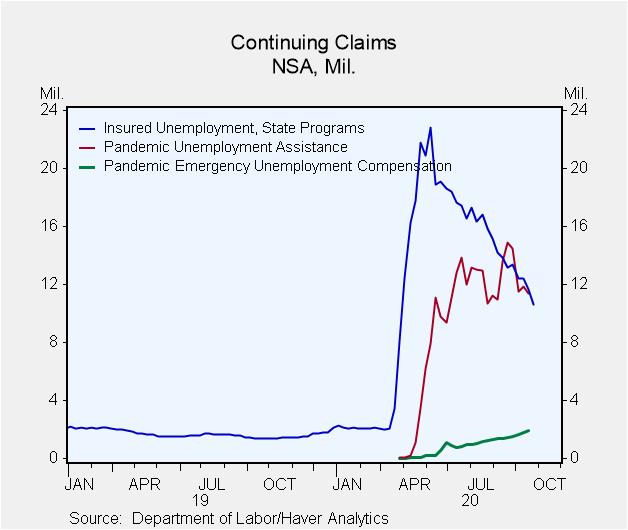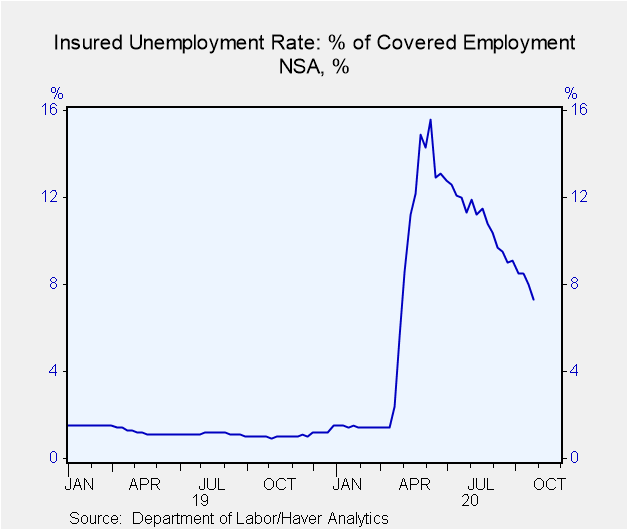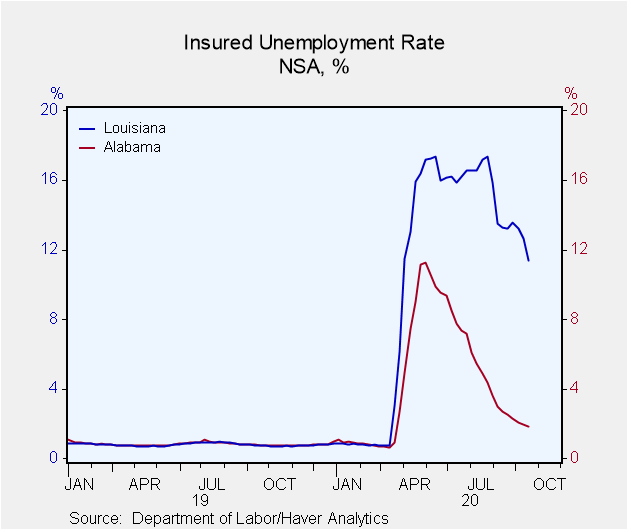 Global| Oct 08 2020
Global| Oct 08 2020U.S. Initial Unemployment Insurance Claims Edged Lower Last Week
by:Tom Moeller
|in:Economy in Brief
Summary
• Initial claims in state programs fell to lowest level since second week of March. • PUA program initial claims fell further. • The insured unemployment rate fell to 7.5%, lowest level since late-March. Initial claims for [...]
• Initial claims in state programs fell to lowest level since second week of March.
• PUA program initial claims fell further.
• The insured unemployment rate fell to 7.5%, lowest level since late-March.
Initial claims for unemployment insurance in standard state programs decreased 9,000 in the week ended October 3 to 840,000 (SA, +296% y/y) from 849,000 in the prior week, revised from 837,000. The Action Economics Forecast Survey expected 820,000.
The Department of Labor now uses additive seasonal factors in its seasonal adjustment process. But data prior to August 29 still utilize the multiplicative seasonal factors. Haver has calculated a series with additive seasonal factors throughout history; the official Labor Department series will be reconciled when standard adjustments are made in January. Not seasonally adjusted initial claims fell last week to 804,000 from 799,000 the prior week.
The special pandemic-related initial claims declined 45,000 to 464,000 from 509,000 in the prior week, revised from 650,000. This program includes "gig workers" or others unemployed who are not ordinarily associated with companies or other organizations giving them access to standard unemployment insurance.
Continuing claims for standard unemployment insurance declined to 10.976 million in the week ended September 26 from 11.979 in the prior week. This is the lowest since the end of March. The number of people receiving Pandemic Unemployment Assistance (PUA) benefits fell 433,506 in the September 19 week to 11.395 million. The number of Pandemic Emergency Unemployment Compensation (PEUC) recipients surged to 1.960 million from 1.806 million one week earlier.
The insured unemployment rate fell to 7.5% in the last week of September from 8.2% in the previous week. This includes the standard state programs only. It was the lowest level since 5.1% at the end of March.
Among the states, the basic insured unemployment rates continue to vary widely. The five lowest rates were in Idaho (1.33%), South Dakota (1.47%), Utah (1.74%), Alabama (1.81%) and Nebraska (2.06%). The five highest rates were in New York (11.10%), Louisiana (11.37%), Nevada (13.73%), California (16.11%) and Hawaii (20.06%).
Note: California has announced a two week pause in its processing of claims to reduce its claims processing backlog and implement fraud prevention technology. Initial claims data from September 19 and continuing claims data from September 12 will be repeated in the weeks that follow until completion of the pause.
Data on weekly unemployment claims going back to 1967 are contained in Haver's WEEKLY database, and they are summarized monthly in USECON. Data for individual states are in REGIONW. The expectations figure is from the Action Economics Forecast Survey, carried in the AS1REPNA database.
| Unemployment Insurance (SA, 000s) | 10/03/20 | 09/26/20 | 09/19/20 | Y/Y % | 2019 | 2018 | 2017 |
|---|---|---|---|---|---|---|---|
| Initial Claims | 840 | 849 | 873 | 296 | 218 | 221 | 244 |
| Initial Claims (NSA) | 804 | 799 | 827 | 328 | 218 | 221 | 243 |
| Initial Claims Pandemic Unemployment Assistance (NSA) | 464 | 509 | 616 | -- | -- | -- | -- |
| Continuing Claims | -- | 10,976 | 11,979 | 546 | 1,701 | 1,756 | 1,961 |
| Continuing Claims (NSA) | -- | 10,612 | 11,622 | 662 | 1,704 | 1,763 | 1,964 |
| Continuing Claims Pandemic Unemployment Assistance (NSA) | -- | -- | 11,395 | -- | -- | -- | -- |
| Insured Unemployment Rate (%) | -- | 7.5 | 8.2 |
1.2 |
1.2 | 1.2 | 1.4 |
Tom Moeller
AuthorMore in Author Profile »Prior to joining Haver Analytics in 2000, Mr. Moeller worked as the Economist at Chancellor Capital Management from 1985 to 1999. There, he developed comprehensive economic forecasts and interpreted economic data for equity and fixed income portfolio managers. Also at Chancellor, Mr. Moeller worked as an equity analyst and was responsible for researching and rating companies in the economically sensitive automobile and housing industries for investment in Chancellor’s equity portfolio. Prior to joining Chancellor, Mr. Moeller was an Economist at Citibank from 1979 to 1984. He also analyzed pricing behavior in the metals industry for the Council on Wage and Price Stability in Washington, D.C. In 1999, Mr. Moeller received the award for most accurate forecast from the Forecasters' Club of New York. From 1990 to 1992 he was President of the New York Association for Business Economists. Mr. Moeller earned an M.B.A. in Finance from Fordham University, where he graduated in 1987. He holds a Bachelor of Arts in Economics from George Washington University.










